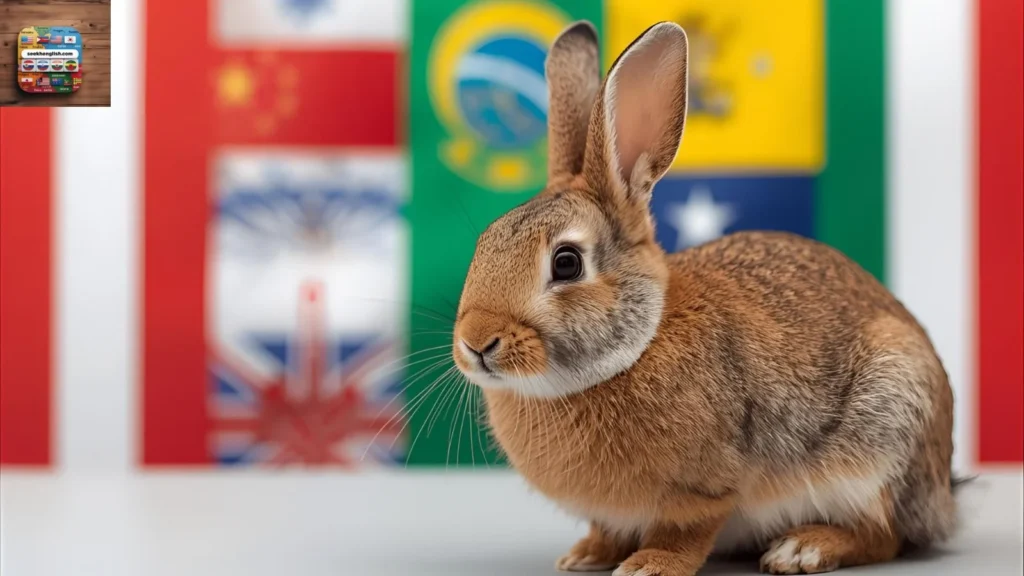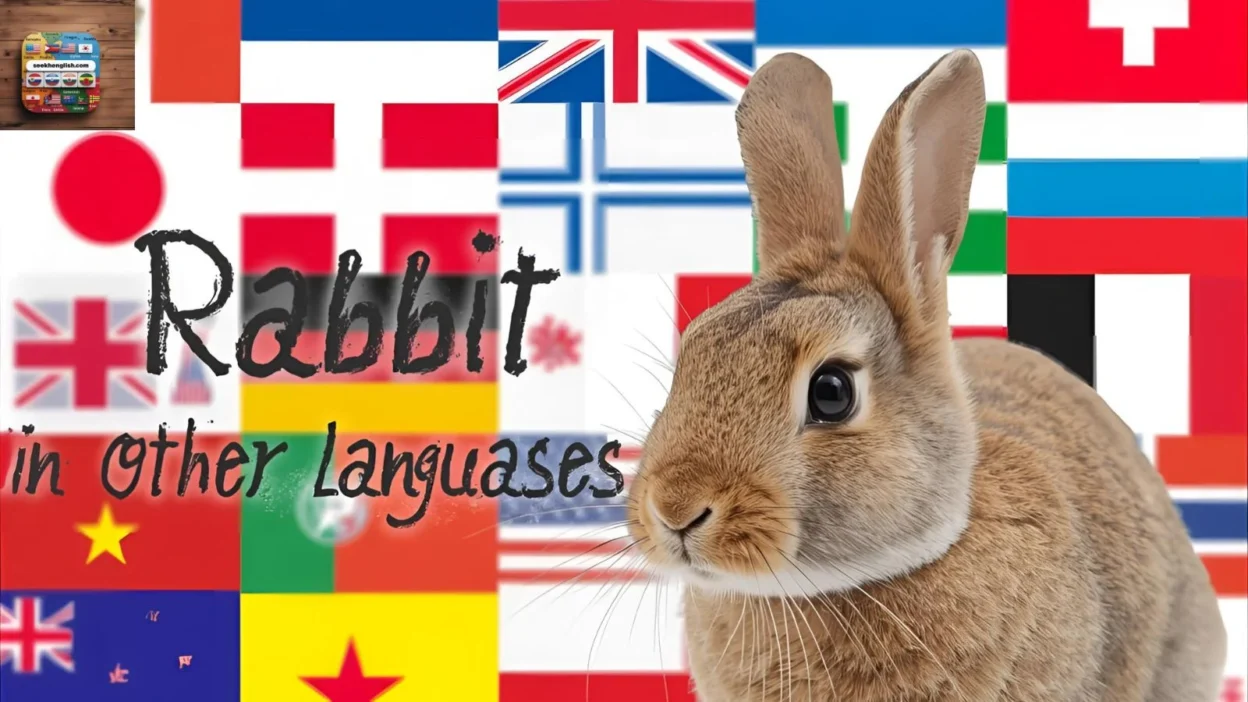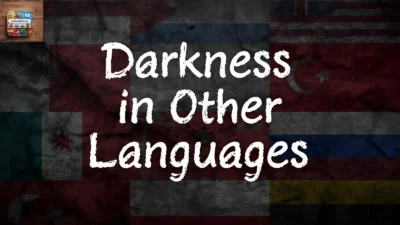Rabbits are gentle, adorable, and found in almost every corner of the world. Whether you’re a language learner, an animal lover, or a traveler, you might want to know how to say rabbit in other languages. People often search for this to enhance conversations, teach kids about animals, name pets, or even write creative stories. Rabbit in Other Languages.
This guide will help you discover 85+ translations of “rabbit”, including pronunciation and example sentences, so you can confidently use the word when speaking to people from different cultures.
Rabbit in Other Languages in 85 Different Languages

Read More: “Earth” in Other Languages
- Afrikaans (🇿🇦) – konyn | Pronunciation: koh-neyn Example: Die konyn eet wortels. (“The rabbit is eating carrots.”)
- Albanian (🇦🇱) – lepur | Pronunciation: leh-poor Example: Lepuri po vrapon në kopsht. (“The rabbit is running in the garden.”)
- Amharic (🇪🇹) – አይራም (ayram) | Pronunciation: eye-rahm Example: አይራም በሳር ላይ ተቀመጠ። (“The rabbit sat on the grass.”)
- Arabic (🇸🇦) – أرنب (arnab) | Pronunciation: ar-nab Example: رأيت أرنب في الحديقة. (“I saw a rabbit in the park.”)
- Armenian (🇦🇲) – նապաստակ (napastak) | Pronunciation: nah-pah-stak Example: Նապաստակը գազար է ուտում։ (“The rabbit is eating a carrot.”)
- Azerbaijani (🇦🇿) – dovşan | Pronunciation: dov-shan Example: Dovşan tarlada qaçır. (“The rabbit is running in the field.”)
- Bangla (🇧🇩) – খরগোশ (khorgosh) | Pronunciation: khor-gosh Example: খরগোশটি লাফাচ্ছে। (“The rabbit is jumping.”)
- Basque (🇪🇸) – untxi | Pronunciation: oon-chee Example: Untxia belarra jaten ari da. (“The rabbit is eating grass.”)
- Belarusian (🇧🇾) – заяц (zayats) | Pronunciation: zah-yats Example: Заяц уцёк у лес. (“The rabbit ran into the forest.”)
- Bosnian (🇧🇦) – zec | Pronunciation: zets Example: Zec skače po livadi. (“The rabbit is hopping in the meadow.”)
- Bulgarian (🇧🇬) – заек (zaek) | Pronunciation: zah-ek Example: Заекът яде морков. (“The rabbit is eating a carrot.”)
- Burmese (🇲🇲) – ယုန် (yon) | Pronunciation: yohn Example: ယုန်က လယ်ထဲမှာ လှုပ်ရှားနေတာ။ (“The rabbit is moving in the field.”)
- Catalan (🇪🇸) – conill | Pronunciation: koh-neel Example: El conill menja pastanagues. (“The rabbit eats carrots.”)
- Chinese – Mandarin (🇨🇳) – 兔子 (tùzi) | Pronunciation: too-dzuh Example: 兔子在跑。 (“The rabbit is running.”)
- Croatian (🇭🇷) – zec | Pronunciation: zets Example: Zec trči po polju. (“The rabbit runs through the field.”)
- Czech (🇨🇿) – králík | Pronunciation: kraa-leek Example: Králík jí salát. (“The rabbit is eating lettuce.”)
- Danish (🇩🇰) – kanin | Pronunciation: kah-neen Example: Kaninen hopper i haven. (“The rabbit hops in the garden.”)
- Dutch (🇳🇱) – konijn | Pronunciation: koh-nine Example: Het konijn eet een wortel. (“The rabbit is eating a carrot.”)
- Dzongkha (🇧🇹) – ཝང་ཤུར་ (wang shur) | Pronunciation: wahng-shoor Example: ཝང་ཤུར་གྱིས་སྡོང་ལོག་གིས་འཁྱགས། (“The rabbit hid in the bush.”)
- English (🇬🇧) – rabbit | Pronunciation: rab-it Example: The rabbit is very cute.
- Estonian (🇪🇪) – küülik | Pronunciation: koo-leek Example: Küülik sööb porgandit. (“The rabbit eats a carrot.”)
- Fijian (🇫🇯) – rapiti | Pronunciation: rah-pee-tee Example: Na rapiti e dro ena were. (“The rabbit runs in the garden.”)
- Filipino / Tagalog (🇵🇭) – kuneho | Pronunciation: koo-neh-ho Example: Ang kuneho ay tumatalon. (“The rabbit is jumping.”)
- Finnish (🇫🇮) – kani | Pronunciation: kah-nee Example: Kani syö salaattia. (“The rabbit eats lettuce.”)
- French (🇫🇷) – lapin | Pronunciation: lah-pan Example: Le lapin mange une carotte. (“The rabbit eats a carrot.”)
- Georgian (🇬🇪) – კურდღელი (kurdkheli) | Pronunciation: koor-dghe-li Example: კურდღელი მინდორში დარბის. (“The rabbit runs in the meadow.”)
- German (🇩🇪) – Kaninchen | Pronunciation: kah-neen-chen Example: Das Kaninchen frisst eine Möhre. (“The rabbit is eating a carrot.”)
- Greek (🇬🇷) – κουνέλι (kouneli) | Pronunciation: koo-neh-lee Example: Το κουνέλι τρώει καρότο. (“The rabbit is eating a carrot.”)
- Gujarati (🇮🇳) – સસલું (saslu) | Pronunciation: sas-loo Example: સસલું બગીચામાં દોડે છે. (“The rabbit is running in the garden.”)
- Haitian Creole (🇭🇹) – lapen | Pronunciation: lah-pen Example: Lapen nan manje kawòt. (“The rabbit is eating a carrot.”)
- Hausa (🇳🇬) – zomaye | Pronunciation: zoh-mah-yeh Example: Zomaye yana gudu a daji. (“The rabbit is running in the forest.”)
- Hebrew (🇮🇱) – ארנב (arnav) | Pronunciation: ar-nav Example: הארנב אוכל חסה. (“The rabbit eats lettuce.”)
- Hindi (🇮🇳) – खरगोश (khargosh) | Pronunciation: khar-gosh Example: खरगोश बगीचे में कूद रहा है। (“The rabbit is jumping in the garden.”)
- Hungarian (🇭🇺) – nyúl | Pronunciation: nyool Example: A nyúl sárgarépát eszik. (“The rabbit eats a carrot.”)
- Icelandic (🇮🇸) – kanína | Pronunciation: kah-nee-nah Example: Kanínan hleypur í garðinum. (“The rabbit runs in the garden.”)
- Igbo (🇳🇬) – oke ọhịa | Pronunciation: oh-keh oh-hee-ah Example: Oke ọhịa na-agba ọsọ. (“The rabbit is running.”)
- Indonesian (🇮🇩) – kelinci | Pronunciation: keh-lin-chee Example: Kelinci itu melompat. (“The rabbit is hopping.”)
- Irish (🇮🇪) – coinín | Pronunciation: kuh-neen Example: Tá an coinín ag ithe cairéad. (“The rabbit is eating a carrot.”)
- Italian (🇮🇹) – coniglio | Pronunciation: koh-nee-lyo Example: Il coniglio mangia una carota. (“The rabbit eats a carrot.”)
- Japanese (🇯🇵) – うさぎ (usagi) | Pronunciation: oo-sah-gee Example: うさぎが庭で跳ねています。 (“The rabbit is hopping in the garden.”)
- Javanese (🇮🇩) – kelinci | Pronunciation: keh-lin-chee Example: Kelinci iku mlumpat. (“The rabbit is jumping.”)
- Kannada (🇮🇳) – ಮೊಲ (mola) | Pronunciation: moh-lah Example: ಮೊಲ ತೋಟದಲ್ಲಿ ಓಡುತ್ತಿದೆ. (“The rabbit is running in the garden.”)
- Kazakh (🇰🇿) – қоян (qoyan) | Pronunciation: koy-ahn Example: Қоян бақта жүгіріп жүр. (“The rabbit is running in the yard.”)
- Khmer (🇰🇭) – ទន្សាយ (tunsay) | Pronunciation: toon-sai Example: ទន្សាយកំពុងលោត។ (“The rabbit is jumping.”)
- Kinyarwanda (🇷🇼) – urukwavu | Pronunciation: oo-roo-kwah-voo Example: Urukwavu ruri kurya imboga. (“The rabbit is eating vegetables.”)
- Korean (🇰🇷) – 토끼 (tokki) | Pronunciation: toh-kki Example: 토끼가 당근을 먹고 있어요. (“The rabbit is eating a carrot.”)
- Kurdish (🇮🇶) – pispor | Pronunciation: pis-por Example: Pispor li nav baxê ye. (“The rabbit is in the garden.”)
- Kyrgyz (🇰🇬) – коён (koyon) | Pronunciation: koy-on Example: Коён чөп жеп жатат. (“The rabbit is eating grass.”)
- Lao (🇱🇦) – ກະຕ່າຍ (katay) | Pronunciation: kah-tai Example: ກະຕ່າຍກຳລັງກະໂດດ. (“The rabbit is jumping.”)
- Latvian (🇱🇻) – trusis | Pronunciation: troo-sis Example: Trusis ēd burkānu. (“The rabbit is eating a carrot.”)
- Lithuanian (🇱🇹) – triušis | Pronunciation: tree-oo-shis Example: Triušis valgo morką. (“The rabbit is eating a carrot.”)
- Luxembourgish (🇱🇺) – Kannéngchen | Pronunciation: kah-nenk-hen Example: D’Kannéngchen spréngt am Gaart. (“The rabbit is hopping in the garden.”)
- Macedonian (🇲🇰) – зајак (zajak) | Pronunciation: zah-yak Example: Зајакот јаде морков. (“The rabbit is eating a carrot.”)
- Malagasy (🇲🇬) – bitro | Pronunciation: bee-troh Example: Ny bitro dia mihinana karaoty. (“The rabbit is eating a carrot.”)
- Malay (🇲🇾) – arnab | Pronunciation: ar-nab Example: Arnab itu sedang melompat. (“The rabbit is hopping.”)
- Malayalam (🇮🇳) – മുയല് (muyal) | Pronunciation: moo-yal Example: മുയല് തോട്ടത്തില് ഓടുന്നു. (“The rabbit is running in the garden.”)
- Maltese (🇲🇹) – fniek | Pronunciation: f-neek Example: Il-fniek qed jaqbeż fil-ġnien. (“The rabbit is jumping in the garden.”)
- Maori (🇳🇿) – rapeti | Pronunciation: rah-peh-tee Example: Kei te kai kāreti te rapeti. (“The rabbit is eating carrots.”)
- Marathi (🇮🇳) – ससा (sasa) | Pronunciation: sah-sah Example: ससा बागेत उडी मारत आहे. (“The rabbit is hopping in the garden.”)
- Mongolian (🇲🇳) – туулай (tuulai) | Pronunciation: too-lai Example: Туулай морк идэж байна. (“The rabbit is eating a carrot.”)
- Nepali (🇳🇵) – खरायो (kharayo) | Pronunciation: kha-ra-yo Example: खरायो बगैंचामा दौडिरहेको छ। (“The rabbit is running in the garden.”)
- Norwegian (🇳🇴) – kanin | Pronunciation: kah-neen Example: Kaninen hopper i hagen. (“The rabbit is hopping in the garden.”)
- Pashto (🇦🇫) – سپینخرگوش (spin khargosh) | Pronunciation: speen khar-gosh Example: سپینخرگوش په باغ کې منډې وهي. (“The rabbit runs in the garden.”)
- Persian (🇮🇷) – خرگوش (khargoosh) | Pronunciation: khar-goosh Example: خرگوش هویج میخورد. (“The rabbit is eating a carrot.”)
- Polish (🇵🇱) – królik | Pronunciation: kroo-leek Example: Królik je marchewkę. (“The rabbit is eating a carrot.”)
- Portuguese (🇵🇹) – coelho | Pronunciation: kwe-lyo Example: O coelho está pulando no jardim. (“The rabbit is jumping in the garden.”)
- Punjabi (🇮🇳) – ਖਰਗੋਸ਼ (khargosh) | Pronunciation: khar-gosh Example: ਖਰਗੋਸ਼ ਬਾਗ ਵਿੱਚ ਦੌੜ ਰਿਹਾ ਹੈ। (“The rabbit is running in the garden.”)
- Quechua (🇵🇪) – kachi chita | Pronunciation: kah-chee chee-tah Example: Kachi chita chakra-pi purin. (“The rabbit walks in the field.”)
- Romanian (🇷🇴) – iepure | Pronunciation: yeh-poo-reh Example: Iepurele mănâncă morcovi. (“The rabbit is eating carrots.”)
- Russian (🇷🇺) – кролик (krolik) | Pronunciation: kroh-leek Example: Кролик ест морковь. (“The rabbit is eating a carrot.”)
- Samoan (🇼🇸) – lapiti | Pronunciation: lah-pee-tee Example: O lo’o oso le lapiti i le togala’au. (“The rabbit is hopping in the garden.”)
- Scots Gaelic (🇬🇧) – coineanach | Pronunciation: koyn-yan-ach Example: Tha an coineanach ag ithe curran. (“The rabbit is eating a carrot.”)
- Serbian (🇷🇸) – зец (zec) | Pronunciation: zets Example: Зец скаче по пољу. (“The rabbit is hopping in the field.”)
- Sesotho (🇱🇸) – mmutla | Pronunciation: mmoot-lah Example: Mmutla o ja lihoete. (“The rabbit is eating carrots.”)
- Shona (🇿🇼) – tsuro | Pronunciation: tsoo-roh Example: Tsuro iri kusvetuka mumunda. (“The rabbit is jumping in the field.”)
- Sindhi (🇵🇰) – خرگوش (khargosh) | Pronunciation: khar-gosh Example: خرگوش باغ ۾ ڀڄي رهيو آهي. (“The rabbit is running in the garden.”)
- Sinhala (🇱🇰) – හාවා (hawa) | Pronunciation: haa-waa Example: හාවා ගසක් යට හිඳී. (“The rabbit is sitting under a tree.”)
- Slovak (🇸🇰) – králik | Pronunciation: kraa-leek Example: Králik skáče po dvore. (“The rabbit is jumping in the yard.”)
- Slovenian (🇸🇮) – zajec | Pronunciation: zah-yets Example: Zajec je korenje. (“The rabbit is eating carrots.”)
- Somali (🇸🇴) – bakayle | Pronunciation: bah-kai-leh Example: Bakayluhu wuxuu cunayaa karootada. (“The rabbit is eating the carrot.”)
- Spanish (🇪🇸) – conejo | Pronunciation: koh-neh-ho Example: El conejo come zanahorias. (“The rabbit eats carrots.”)
- Swahili (🇹🇿) – sungura | Pronunciation: soon-goo-rah Example: Sungura anakimbia shambani. (“The rabbit is running in the farm.”)
- Swedish (🇸🇪) – kanin | Pronunciation: kah-neen Example: Kaninen hoppar i trädgården. (“The rabbit is hopping in the garden.”)
- Tamil (🇮🇳) – முயல் (muyal) | Pronunciation: moo-yal Example: முயல் தோட்டத்தில் குதிக்கிறது. (“The rabbit is jumping in the garden.”)
- Telugu (🇮🇳) – కుందేలు (kundelu) | Pronunciation: koon-day-loo Example: కుందేలు తోటలో దూకుతోంది. (“The rabbit is jumping in the garden.”)
Conclusion
No matter where you are in the world, the word “rabbit” brings smiles, warmth, and a reminder of nature’s gentle beauty.



